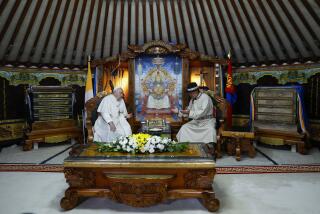Mongol Rally, Day 9: Putting memories to rest in Chernobyl
- Share via
I have no special talents. I am only passionately curious.
--Albert Einstein
I vividly remember the day in 1986 when the Chernobyl nuclear reactor exploded. I was 9. My next-door neighbor came rushing in holding a newspaper aloft, telling me of the disaster in the Ukraine and the impending doom -- a radioactive cloud -- heading toward London. I was petrified.
I rushed to my mother and asked when the cloud was coming and how were we going to escape. She reassured me that the accident was too far away to affect us. The memory never left me. Since that day I have always had this urge to visit Chernobyl. The name still sends tingles down my spine.
On Sunday I got my chance when Steve Priovolos and I stopped on our drive from Britain to Ulan Bator, Mongolia, as part of the 10,000-mile Mongol Rally. The rally began July 14 and is expected to last five weeks.
Chernobyl is a surreal place. There is an 18-mile exclusion zone where no one is allowed -- except for a small cadre of workers and tourists like me, who are too curious for their own good.
Chernobyl is a ghost town. Nature has taken over. Derelict buildings are everywhere. Remnants of lives, which used to fill the squares of this Soviet bastion, are evident. Women’s shoes. Children’s dolls. Shopping carts. Memories of a way of life extinguished.
My guide gave Steve and me a Geiger counter that showed us the radiation levels. He also assured us that everything was safe. The Geiger counter begged to differ. At times it went above 8.0. A safe level is 0.30. Not very reassuring.
When it was time to leave we had to pass through two separate radiation meters. These Soviet-era-looking machines checked whether we had been contaminated. Any contaminated item would be left behind or decontaminated. This included humans.
Luckily we were all radiation-free.
More to Read
Sign up for The Wild
We’ll help you find the best places to hike, bike and run, as well as the perfect silent spots for meditation and yoga.
You may occasionally receive promotional content from the Los Angeles Times.






